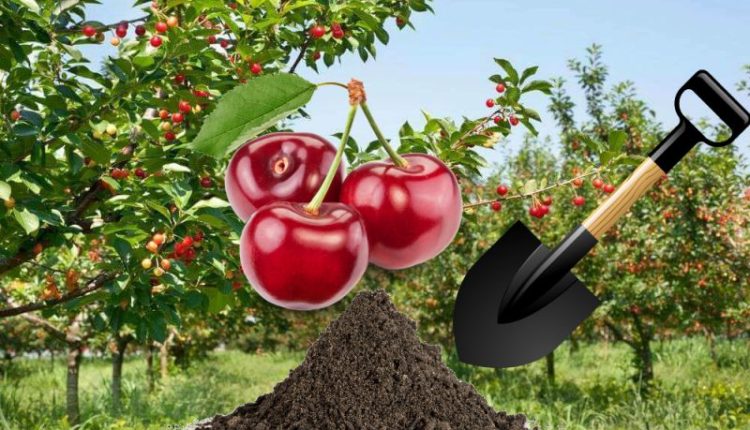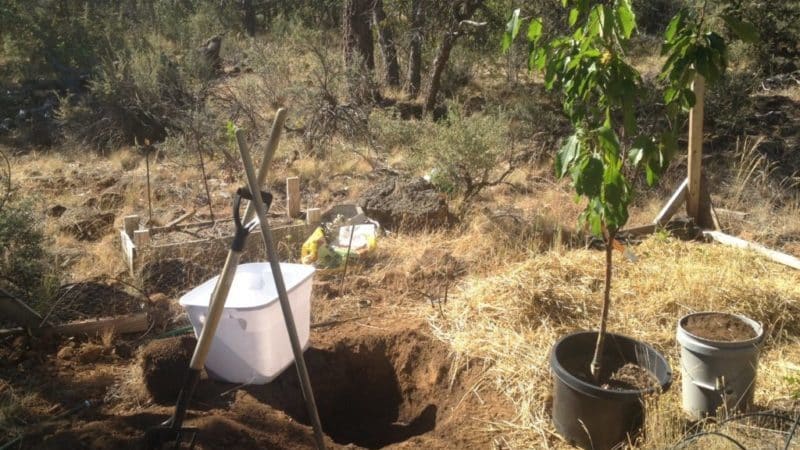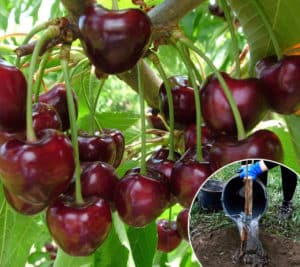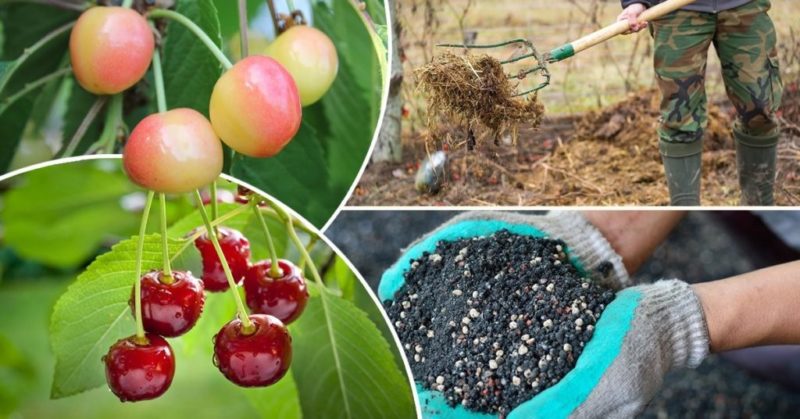A guide to replanting cherries in summer for beginning gardeners
The best period for planting cherries is autumn. But sometimes circumstances arise in which it is necessary to transplant a tree at a less favorable time. At such moments, a novice gardener has a lot of questions. How to organize work so as not to damage the tree, whether it is possible to replant an adult, for example, five-year-old cherry tree, how to choose a favorable day for the event, you will learn from the article.
Why replant cherries in summer?
Replanting fruit and berry trees in the summer is not a good idea. Successful results of summer planting work are not guaranteed. Transplanted specimens require increased attention from the gardener and especially careful care. During the hot summer months, it is difficult for the plant to adapt to new conditions, take root and grow stronger.
But if construction is planned on the site, a change in landscape design, or a new one is purchased unplanned cherry variety, There is no point in waiting for a favorable time of year.

When is the best time to replant mature cherries?
In the summer, it is permissible to replant only young plants no older than 5-6 years. Planting material must be healthy, without signs of disease or damage.
Transplanting a tree at fruiting age can disrupt its natural life processes.
Mature trees react painfully to even minor damage to roots and branches.Therefore, it is possible to move middle-aged cherries to a new location only by transshipment. But even with careful adherence to all agricultural techniques, the tree can wither and die.
Favorable days according to the lunar calendar
In order not to make a mistake with the choice of day landings, you can refer to the lunar calendar. He will tell you the best moments for working with the soil and the most favorable periods for seedlings, when they are full of vitality and can easily take root in a new place.
Favorable days for planting cherries in summer 2020:
- June: 1-5, 8, 12-13, 17-18, 22-23, 26-30;
- July: 2-3, 7-13, 21-24, 27-31;
- August: 1, 3-5, 7-11, 14-15, 17-19, 21-23, 27, 30-31.
It is recommended to postpone gardening work on June 9-11, 14-16, 24 and 25, July 7-8, 11-13, 21-22, August 3-4, 8-9, 17-18, 30-31. During these periods, plants are weakened and prone to disease.
Choosing a landing site
Cherry is a heat-loving and light-loving plant. She doesn't like excess moisture and drafts. The crop is very demanding on the soil: it prefers fertile, light soil with neutral acidity. The ideal soil for cherries is light sandy loam or loamy soil.
Note! You cannot plant a tree in heavy clay or peaty soil. The cherry tree will not live long on such a cherry tree.
Young trees are planted at a great distance from each other - at least 4.5 m, otherwise the plants will compete with their neighbors for water and food. This will not have the best effect on their development and productivity.
Experts recommend growing several trees on the site, since this crop is cross-pollinated.
Favorable and unfavorable neighborhood
The best neighbors for cherries are plums and cherries.
Small berry bushes (for example, currants, gooseberries) cherry will not allow it to develop. Its long surface roots will take all the moisture and nutrients, and the spreading crown will shade low plants. For the same reason, rose bushes do not grow next to cherries.
It is not advisable to plant cherries in the same area as apricot, apple tree, pear, walnut.
This is interesting:
What are good cherry-cherry hybrids and what are their features?
Review of the best winter-hardy cherry varieties and criteria for their selection
Preparing for transplant
You need to prepare for transplanting cherries in advance. You should select the right place in the garden, carefully select planting material, and prepare the soil.
It is recommended to buy seedlings from a nursery and make sure that there is a main guide. Otherwise, the tree will bush excessively, and after fruiting the trunk, unable to withstand the load, may break. The roots of the seedling must be free of mechanical damage, at least 15 cm in length, and not dried out.
The soil for planting is dug up in advance and weeds are removed. If the soil is too heavy, add sand. This is especially useful when replanting bare-rooted trees.
Regarding soil fertilization, expert opinions differ. Some people believe that compost, rotted manure, sawdust or dry leaves are always useful. Others are of the opinion that with a lack of oxygen in the soil, the decomposition of organic matter will take years, and the harm from such fertilizing will be more than good.
Work with chemical fertilizers very carefully so as not to burn the roots.
In general, it is advisable to create the same conditions for a young tree in a new place as in the previous one.
Transplant instructions

When transplanting cherries, use ordinary gardening tools.All you need is a shovel and support for the seedling. Experts advise using a metal or plastic pole to support the tree.
Before planting, the roots of the seedling are inspected, damaged and too long ends are cut off. Then the plant is placed in water for 2 hours so that the roots are saturated with water. If the bush has dried out during transportation, you need to keep it in water for about 10 hours. It is better to tear off the leaves so as not to dehydrate the bush.
How to transplant cherries to another place:
- Dig a hole the size of the root ball, but not less than 50-60 cm deep.
- If organic matter or chemical fertilizers are poured into the bottom, they must be sprinkled with fertile soil so that the roots do not come into contact. In this case, the hole should be deeper.
- Install a support to keep the plant balanced.
- Place the seedling and straighten the roots.
- Cover with soil and compact.
- Water generously - at least 1 bucket per bush.
- Mulch the ground around the seedling (sprinkle with leaves, sawdust, peat or humus).
Common Mistakes
When replanting fruit trees for the first time, they make the following mistakes:
- They are too lazy to dig a deeper hole. The soil on the surface is looser than at depth. It is difficult for fragile tree roots to overcome it in order to begin to grow. The seedling will not die, but it will noticeably lag behind in development. Recommendation: pour loose topsoil onto the bottom of the planting hole and fill the voids with fertile soil.

- They put earthen banks around the bush to make watering more convenient. Recommendation: do not fill the planting hole with soil to the brim, leave it in the shape of a plate with a seedling in the center. In summer, this depression can be mulched.
- They feed the plant with fertilizers from the heart. Abuse will most likely harm the seedling.Recommendation: mix a handful of ash with soil and pour it into the bottom of the hole. There is no need to distribute fertilizer throughout the entire volume of the pit.
- Deepen the root collar. This leads to the death of the plant. Recommendation: wipe the lower part of the trunk and the beginning of thick roots with a damp cloth. The root collar boundary is where the bark changes color from greenish to brownish. When transplanting, the root collar should be 3-6 cm above the ground.
The nuances of transplantation
Summer replanting of cherries is suitable only for the central regions of the country. In the south it makes no sense. Autumn gardening is an ideal time for the hot southern regions.
When transplanting a young bush, you should focus on the cardinal directions. The grafting site is located on the north side so that the plant does not receive burns or damage to the bark.
Cherries older than 3 years are planted in the same way as they grew in the same place. An adult plant must be moved with a clod of earth. The main branches are cut by 1/3 when planting. The cut site is treated with garden varnish or drying oil.
To prevent the seedling from experiencing a lack of moisture, the trunks at the base of the skeletal branches can be wrapped in rags and periodically moistened with water. Be sure to secure the tree with reliable guy ropes. Then the trunk will not be damaged by the wind.
Note! You should not count on a harvest next summer after replanting. The plant takes 2 years to take root in a new location. If the cherry blossoms bloom during this period, it is better to remove the flowers so that fruiting does not weaken the still weak tree.
Further care
Water the tree depending on the weather, regularly, but moderately, so as not to waterlog the soil.
It is recommended to fertilize plants no earlier than a year after planting, preferably with water-soluble mineral fertilizers.
Regular inspection allows you to detect pests or initial signs of diseases and promptly take measures to eliminate them.
Advice from experienced gardeners

It is worth listening to the recommendations of those who have been successfully growing cherries for many years:
- In addition to nurseries, wild cherries for planting can be dug up where they are not needed and are usually cut down: from under power lines, near roads, in quarries.
- You should dig up a tree with a large lump of earth and try to minimize damage to the roots.
- When transporting, the roots of the seedling are wrapped in a wet cloth and packed in a plastic bag or oilcloth.
- When planting, the space between the lump of earth and the edges of the hole is filled with a mixture of earth and sand in a ratio of 6:4 so that the roots can breathe easier.
- A piece of fabric is placed between the rope attaching the tree to the stakes and the trunk so as not to damage the young bark.
Conclusion
To transplant cherries to another place, it is enough to select a large, well-lit plot of land, purchase or dig up a healthy, strong tree, and prepare the soil.
It is necessary to water and feed the plants abundantly, but without fanaticism, and weed the weeds. And the main thing is to love your garden. Compliance with these rules will help the cherry tree get stronger and get used to the new place.